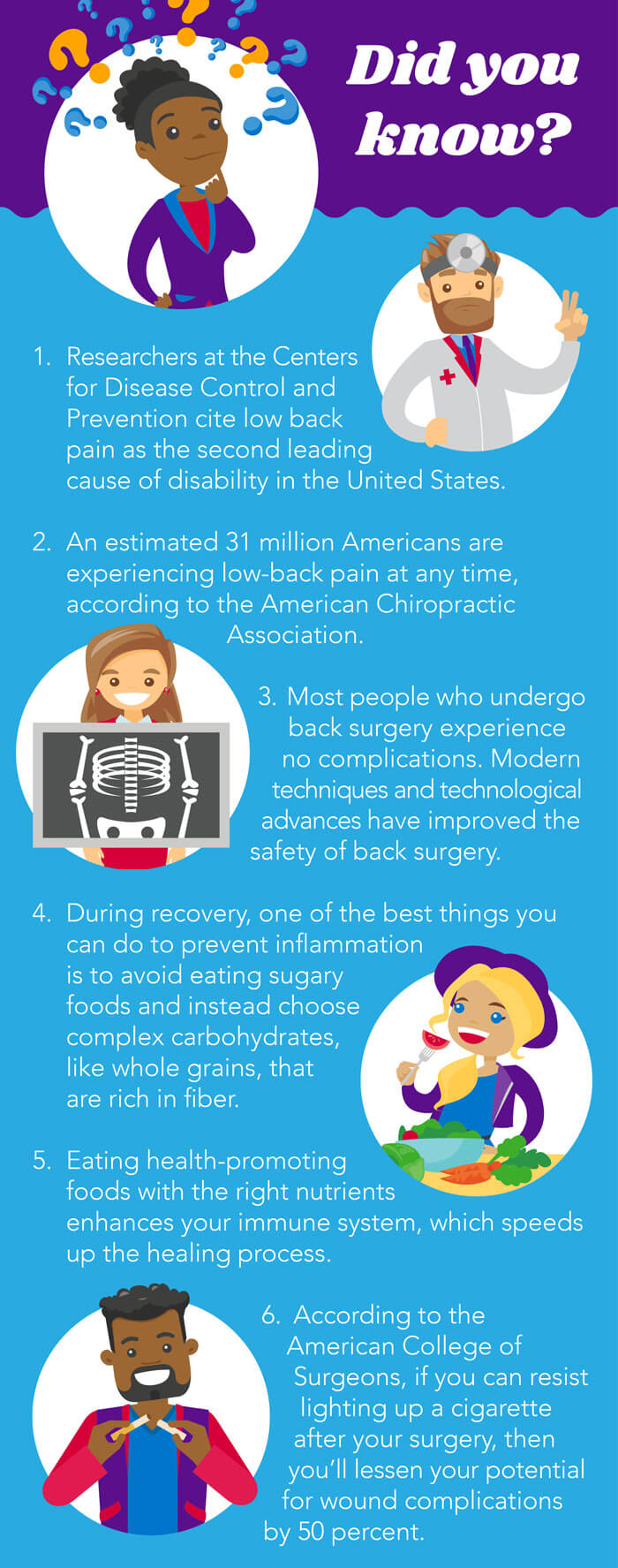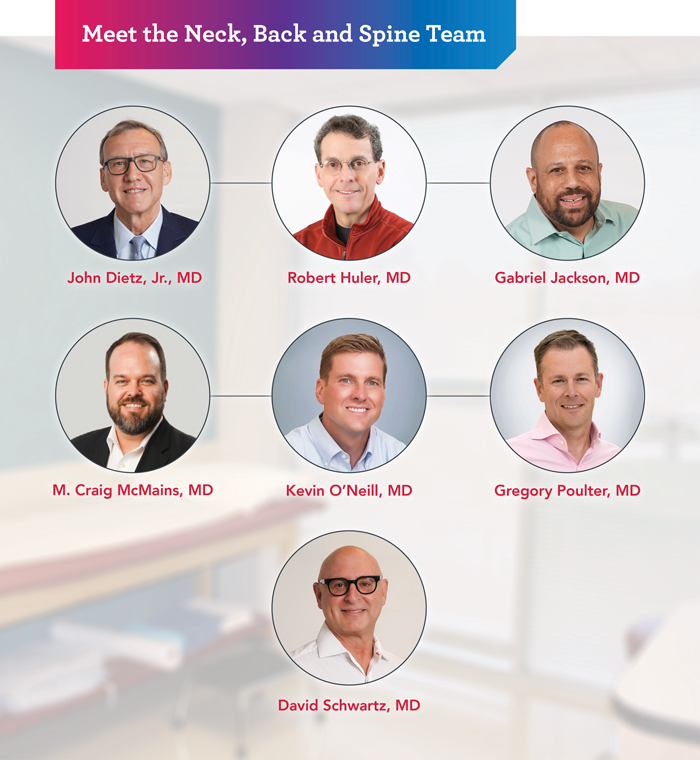The ultimate guide to
Back Pain Relief
Get back to feeling normal. This comprehensive guide will help you understand what your back pain means, pinpoint where it comes from, and explore the benefits of different treatment options.

This guide discusses...
Living with chronic back pain is not normal
Back pain is a thief that steals your quality of life and makes everyday tasks harder. But, you don’t have to suffer. There’s hope for getting back to feeling normal with customized treatment.
The first step is to identify what is wrong. Our ultimate guide to back pain relief will help you recognize your problem, understand what your pain means, where it comes from and what treatments are available. Whether you’re in the first stage of research or you’ve already decided to have back surgery, this guide includes answers to common back pain questions and examples of real patient success stories.
1 Back pain causes—and, what you can do
Back pain is your body’s way of telling you to slow down and notice that something is wrong. In most cases, back pain is due to a sprain or strain.
Take back pain seriously
It is important that you pay attention to back pain. When left untreated, back injuries tend to compound, causing other injuries. Sprains lead to strains. Strains lead to sprains. Signs that you might have a back injury:
- Constant aching pain
- Muscle spasms
- Weakness
- Limited range of motion
- Headaches
- Numbness in your legs or feet
- Shooting pain down your leg
- Increased pain due to lack of movement
- Bowel and/or bladder changes
Tips for managing back pain symptoms
Has back pain caused you to miss work? You’re not alone. The number of people suffering with back pain is on the rise. In fact, researchers at the Centers for Disease Control and Prevention cite low back pain as the second leading cause of disability in the United States, and the latest numbers indicate that an estimated 31 million Americans are experiencing low-back pain at any time, according to the American Chiropractic Association.
Recovery starts when you seek help and figure out what’s wrong. Meet with a back doctor to start a personalized treatment plan to help you get back to living pain free.

In some cases, non-surgical strategies can help reduce back pain, including: several non-surgical strategies that can help reduce back pain symptoms.
- Avoid any activities that trigger your back pain.
- Take over-the-counter medication, such as Aleve or Advil, as needed. If you’re using the medication to mask your pain, you might continue to damage your back. Talk to a doctor for guidance if you’re unsure.
- Use a heating pad/cold pack (or alternate between the two).
- Get a massage. Massage therapy reduces muscle stiffness and increases blood flow.
READ ARTICLE: ARE MASSAGES GOOD FOR BACK PAIN?
Implement some lifestyle changes
Looking for ways to alleviate some of your back pain symptoms without surgery? Consider making these lifestyle changes to improve your overall health:
Keep exercising: Sometimes, when you have chronic back pain, the last thing you want to do is move a lot because it aggravates your injury and causes more suffering. But, even if you can’t do all of the things that you used to enjoy before your injury that doesn’t mean you have to give up staying active all together. Exercising can help stretch your back and strengthen your core. If you’re able to keep exercising, talk to your back doctor about including a low-impact aerobic activity, such as swimming or walking, as part of your fitness routine. Or, work with a physical therapist to develop a customized set of activities you can do that won’t cause additional pain.
Lose weight: Doctors always recommend maintaining a healthy weight for its many physical benefits, and among those perks for some people is diminished back pain. If you carry extra weight, experts find that it often puts additional persistent stress on your back which can cause more severe and extensive pain. Most people find that losing a few pounds substantially reduces soreness because being at a healthy weight decreases the trauma placed on their spines.
Download our Ultimate Guide to a Healthy Lifestyle for Weight loss tips and more
Stop smoking: If you need a reason to think twice before you light up, know that researchers have found that smoking can exacerbate your aches. That’s because smoking leads to faster degeneration of the spine and increased back pain. And, if you are a heavy smoker, unfortunately coughing fits can increase your suffering, too. Though nicotine can be a painkiller, in the long run you’ll find greater relief for your chronic back pain if you work with your doctor to kick the habit. Learn more
Key concepts
- Strain: When your muscle has been stretched too far and tears
- Sprain: When your ligaments are damaged through movement
- Herniated disk: When the cushion between vertebrae ruptures and irritates your nerves
- Spinal stenosis: When the space within your spine narrows and puts pressure on your nerves
 Dr. Meredith Langhorst discusses back pain and how certain types of workspaces can affect your back and add stress to other body parts.
Dr. Meredith Langhorst discusses back pain and how certain types of workspaces can affect your back and add stress to other body parts.
2 Non-surgical and surgical treatment options
Reducing most back pain symptoms doesn’t require surgery. You can use nonsurgical means and experience successful results. Sometimes, identifying and stopping any activity that is causing your back pain for a few weeks is enough to alleviate minor back pain problems.
Physicians who specialize in non-operative spine care use medication, physical therapy and interventional procedures to help reduce pain and get back to your normal routine.
“Non-operative spine physicians work very closely with the spine surgeons in the same clinic,” explains OrthoIndy spine surgeon, Dr. Kevin O’Neill. “It is not uncommon for them to walk down the hall with an X-ray, knock on the door and have an immediate discussion about treatment options.”
If back surgery is necessary, pain management spine physicians can assist with back pain treatment options during the interim.
Download our ultimate guide to non-surgical orthopedic care to learn about alternatives to surgery
Surgical emergencies
Surgical emergencies for back pain are extremely rare, but they can occur. If you experience a medical emergency such as loss of bowel and/or bladder control or if you develop progressive weakness or numbness in your legs, please make an appointment to see a spine specialist right away.
When is back surgery a good idea?
In most cases, surgery is considered only when you’ve gone through all the nonoperative treatment options and you haven’t had significant or lasting improvement. Deciding on surgery often has to do with pain levels, the amount of disability, the length of time you’ve been in pain and what treatments you’ve already tried.
Elective back surgery is always your choice. But, some back pain problems will only get better with surgery. Your back doctor will work with you to make sure you make an informed and educated decision.

Get a Spine second opinion
Have you had a spine image done at another facility? An OrthoIndy spine surgeon will give you a second opinion.
“If we can look a patient in the eye and say that this surgery is the only way to lead a painfree life, then that is the conversation we want to have,” shares OrthoIndy spine surgeon, Dr. Greg Poulter. “We want to replace fear and lack of understanding with a clear communication about treatment goals and a plan for getting better.”
Spine surgery is recommended to treat the following conditions:
Nerve or spinal cord compression: When your spinal cord or nerves are compressed, it can cause pain, numbness, tingling, weakness, loss of coordination or balance, and even trouble with bowel and/or bladder function.
Instability: Lower back instability often results from fractures or the degeneration or aging of your spine. Your spine surgeon may have to make your spine unstable in order to relieve pressure on the nerves.
Spine deformities: When your spine loses its normal shape, the result may be scoliosis or kyphosis. Surgery is sometimes used to restore the alignment of the spine.
Back and neck surgeries performed at OrthoIndy
OrthoIndy Spine Robotics Program
OrthoIndy Hospital was the first facility in Indiana to add the Mazor X™ Robotic Guidance System to its hospital. The Mazor X Robotic Guidance System combines pre-operative planning tools and analytics with intra-operative guidance, giving OrthoIndy spine surgeons advanced spinal surgery options.
Right now, OrthoIndy spine surgeons are using the Stealth Edition of the Mazor X Robot. As one of first five sites in the world to be using this edition, OrthoIndy offers a fully-integrated procedural solution for surgical planning, workflow, execution and confirmation for back surgery patients.
Hospitals choose the Mazor X System to provide surgeons with pre-operative assessment of a patient and intra-operative trajectory precision when treating that patient. As spinal surgery has evolved, more focus has been placed on minimally invasive techniques, and this is where the Mazor X System can deliver its greatest technological benefits.
Surgery with Mazor Robotics technology provides increased safety and precision for a wide variety of spine procedures, and in some cases, allows for minimally-invasive surgery.
If you are one of the many that suffer from a debilitating spinal condition or back pain, you may be a candidate for spine surgery with the Mazor X Robotic Guidance System.
Download your free copy of the OrthoIndy Spine Robotics Guide
Key concepts
- Nonsurgical treatment: Develop and follow a pain management plan that includes diet, exercise, physical therapy and medication.
- Surgical treatment: Work with your spine surgeon to determine the best surgical solution based on your specific condition and goals.
3 Is back surgery worth it?
Planning back surgery starts with understanding your goals. Talk with your back surgeon about what your idea of success looks like and describe your ideal post-surgery outcome. Make sure your back doctor understands your expectations for recovery and beyond.
With all of this personal information, your spine surgeon will be able to give you a realistic idea of how likely surgery will reach your recovery goals. “We are advocates for our patients,” says Dr. Poulter. “Recommendations are based on our research, training and experience, and we take the time to explain what you can expect.”
For most patients, the primary goal of back surgery is to reduce pain, increase mobility and improve quality of life. However, living pain-free is just the beginning. It’s amazing how something like back pain can make the every day so much more difficult. Many find that after successful back surgery, they sleep better and their mood improves, too.

Do you really need back surgery?
Planning for back surgery starts with understanding your goals. Learn more about the pros and cons of back surgery and what will work for you.
Sample questions to ask your spine surgeon
- What is your ideal outcome? What are your surgeon’s expectations?
- What type of back surgery is your surgeon recommending and why?
- What problems will having this type of back surgery solve? (And, what cannot be fixed by this surgical procedure?)
- What can you expect if you don’t have back surgery?
- How long will the surgery take?
- What are the risks? (And, what can you do to reduce those risks?) Should you donate blood for your surgery?
- Who will be your operating surgeon? (And, how many times has he/she done the surgery?)
- What has happened with other patients who have had this surgery?
- What should you expect after the surgery?
- How long will you be in the hospital?
DOWNLOAD AND PRINT QUESTIONS TO ASK YOUR DOCTOR BEFORE BACK SURGERY
In most cases, the benefits of having surgery far outweigh the potential complications or risks. As serious as back surgery seems, most people who undergo back surgery experience no complications. Modern techniques and technological advances have improved the safety of back surgery. Your back doctor will work with you to reduce the possibility of any complications.
If your condition does require surgery, OrthoIndy Hospital has been a Five-Star Recipient for Spinal Fusion Surgery by Healthgrades from 2014 to 2025.


READ ARTICLE: WHAT LEVEL OF SUCCESS SHOULD I EXPECT AFTER BACK SURGERY?
OrthoIndy scoliosis patient discusses life after scoliosis surgery. To learn more about Alyssa’s experience with OrthoIndy, view Alyssa’s before surgery video or Alyssa’s during surgery video.
4 What to expect when recovering from back surgery
Recovery begins before you head into the recovery room. Recovery is about making sure your body and your environment is prepared to help you heal.
How healthy habits can speed up your recovery
“When it comes to aiding recovery, I can’t overstate the importance of a good diet, exercise and not smoking,” says Dr. O’Neill. “When a patient is unfit, surgery can amplify problems and slow recovery.”
Proper nutrition can make recovery easier. Eating health-promoting foods with the right nutrients enhances your immune system which speeds up the healing process. When you eat foods rich in antioxidants and protein, your body’s muscles mend more quickly and you’re more likely to avoid problems with infection. During recovery, one of the best things you can do to prevent inflammation is to avoid eating sugary foods and instead choose complex carbohydrates, like whole grains, that are rich in fiber.
Becoming active before and after surgery provides advantages during your healing process. During recovery, your spine physician will have you move in very specific ways to strengthen your core muscles. You’ll even get specific instructions for turning in bed to avoid damage.

The Ultimate Guide to a Healthy Lifestyle
Learn how to eat healthy, exercise, lose weight and maintain a positive outlook on life to achieve your goals.
Finally, consider using your back surgery as a reason to stop smoking. Smokers have an increased risk of complications during and after surgery. Experts recommend trying to quit smoking four to six weeks before your surgery. And, don’t stop there. According to the American College of Surgeons, if you can resist lighting up a cigarette after your surgery, then you’ll lessen your potential for wound complications by 50 percent too.
Learn more about the effects of smoking after surgery and how to quit (Blog article)
What to expect immediately after your back surgery
After surgery, you’ll be up and walking within the first 24 hours. During your hospital stay, you’ll see a physical therapist each day. He will teach you how to sit up, roll over in bed and get out, walk, stand and use a walker. Your physical therapist will also be one of the decision makers who helps assess when you’re ready to go home.
You may notice some swelling. This will diminish over the next two days. Your back doctor will have you use an intermittent pneumatic compression device or have you wear compression leggings, called TED hose. Both of these help prevent blood clots while you are immobile.
Key Concepts
- Be ready: Recovery begins before surgery.
- Don’t be overwhelmed: Download the surgery checklist to make sure you are ready for surgery and recovery.
Use this pre- and post-operation checklist for successful back surgery recovery
5 The cost of back surgery
You know you have to have surgery, but the cost of medical expenses can be worrisome. The following tools are helpful when comparing the cost of surgery and quality of care between hospitals.
Insurance
First, it’s important to check with your insurance provider to ensure OrthoIndy is in your network.
OrthoIndy and OrthoIndy Hospital participates in most major insurance networks. Many insurance companies have pricing tools that take into account your benefit plan. Visit your insurance provider’s website to see if this is available to calculate surgery costs.
Pricing
Another resource to review surgery pricing is the mycareinsight.org website.
The Indiana Hospital Association (IHA) developed the website using data that is reported to the Centers for Medicare and Medicaid Services and the Indiana State Department of Health.
The data reported on this website includes measures of care provided in the hospital, including patient satisfaction, readmissions, infections, deaths, birthing outcomes, hospital charges and more.
According to the mycareinsight.org, spine surgery at OrthoIndy Hospital costs less than the state average for inpatient spine procedures. Nationally, OrthoIndy Hospital performs better than average for patient experience and has low hospital acquired infections and readmission rates.
Visit mycareinsight to compare hospital pricing for spine surgery.
6 Resources
Blogs
- What are surgical and nonsurgical options for back pain?
- Should I talk to an orthopedic doctor about back surgery?
- What level of success should I expect after back surgery?
- Are there ways to speed up back surgery recovery time?
- Does OrthoIndy take my insurance?
- What is scoliosis?
- What is kyphosis?
- What is cervical myelopathy (spinal cord compression)?
- What is a fractured spine?
- What is degenerative disc disease?
- Spine MRI Second Opinion
- How to stop smoking
- What to expect during the diagnosis and treatment process when you see a doctor for back pain
- Are massages good for back pain?
Downloadable guides
- The Ultimate Guide to Back Pain Relief
- The Ultimate Guide to a Healthy Lifestyle
- The Ultimate Guide to Non-surgical Orthopedic Care
- OrthoIndy Spine Robotics Guide
- The pros and cons of back surgery
- Questions to ask your spine surgeon before surgery
- A pre-surgery and recovery checklist for back surgery patients






